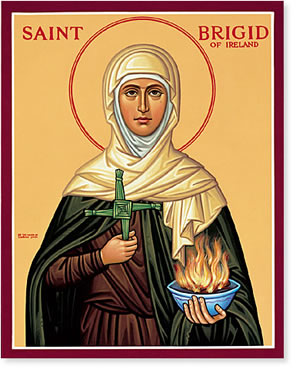|
|||
|---|---|---|---|
| This weekly bulletin insert complements the curriculum published by the Department of Christian Education of the Orthodox Church in America. This and many other Christian Education resources are available at http://dce.oca.org. | |||

One of the Orthodox Church's great ancient saints is Brigid of Ireland. Born in about 451, she was the daughter of an Irish chieftain and one of the female slaves in his court. Even as a child, Brigid apparently noticed and cared about poverty and destitution, responding by giving away her own and her family's considerable possessions to people in need. This generosity did not meet with the wholehearted approval of her father, who complained to a friend that his daughter was bankrupting his household. The friend answered, "Let her be. She has more virtue before God than either you or I." Brigid grew into a cultivated, energetic young woman with a sunny spirit. She had plenty of chances to marry, but turned them down and followed her desire to be a nun. With several other young women she established a monastic community, located under a large oak tree. It became known as the "Church of the Oak" (in Gaelic Cill-Dara), and she is sometimes called "Brigid of Kildare"--an English rendering of Cill-Dara. The community grew in numbers, reputation and achievement. Brigid was the abbess, and continued her care for the poor, selling whatever she had to give them what they needed. People who lived in the area flocked to the monastery to receive medical help and food, and to pray with the nuns. They would often see the abbess out in the fields, tending to the community's cattle. Brigid and the sisters cared for the local children as well, establishing schools and training centers for them. Others heard of these efforts, and before long the abbess was traveling all over Ireland to start schools, oversee the building of hospitals, and encourage people in their faith by her own steadfast, cheerful example. Under Brigid's direction, the monastery itself became the site of an art school, where metal work and manuscript illumination (decoration of manuscript pages with colored figures and designs) were taught. The products of this school included a Gospel book, famously beautiful for its harmony of colors and intricate designs. To some it almost seemed that this "Book of Kildare" must have been the work of angels, with human beings merely copying the figures shown to them by celestial beings. Unfortunately, the book was later lost. Brigid was a contemporary of Saint Patrick, Enlightener of Ireland, and a partner in spreading and strengthening the Christian faith throughout the country. There are many stories of their common work, and one involves a time when Brigid, perhaps exhausted by her labors and travels, fell asleep during one of Patrick's sermons. Rather than being miffed or reproachful, he simply asked his friend, "What did you dream about?" Brigid replied that she had had a most curious dream. She saw white-clothed sowers, peacefully sowing seed in a field. They were followed by another group of sowers, hunched over and wearing dirty clothes, who with hurried, jerky movements sowed weeds in the same field. Patrick told her the meaning of her dream. It was a stark prediction: After all the work the two saints had done to "sow" the true faith in Ireland, false teachers would come along and do their best to destroy it.
Perhaps many of us, if we could know beforehand that others would work vigorously to destroy our life's work, would ask, "What's the use?" and give up. Or would we find the faith and fortitude to continue working anyway, leaving the results in God's hands? Would we find strength even in dark times, when others failed us? Saint Brigid did continue to work. She is one of the most beloved and appealing saints in the Church calendar. She is the patron of milkmaids, fugitives, printing press operators, chicken farmers, poets, and children whose parents are not married. Among her many titles is "Patroness of the Green Isle." |
|||
